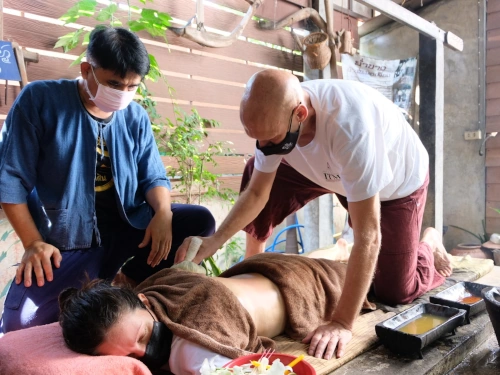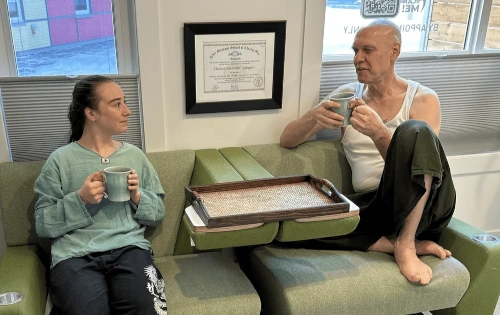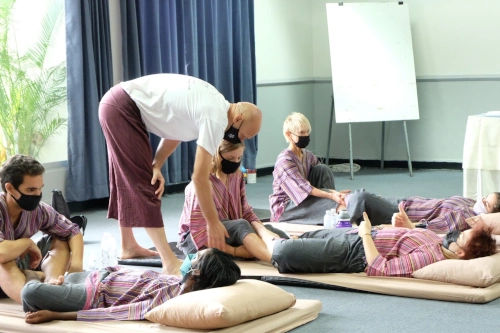Becoming a Thai Massage Practitioner
Monday, June 30, 2025, 12:00 PM
Culture, Certification, and Care
As Thai massage continues to grow in popularity worldwide, finding its way into wellness studios, therapy centres, and classrooms across the globe, conversations about training and certification have become increasingly relevant.
We sat down with NHPC board member, Thai massage practitioner, and instructor Grant Martens to explore Thai massage's cultural, educational, and professional dimensions as well as its challenges and the importance of preserving its authenticity.

From Farming to Healing: Meet Grant Martens
Before becoming a Thai massage instructor, Grant's careers were farming, pastoring, and working in IT for small businesses. His formal education is in music, religious studies, and philosophy. He enjoys being active in martial arts and theatre in his spare time.
His first Thai massage wasn't just a relaxing experience — it felt deeply familiar. The stretches reminded him of the partner work in martial arts training. It did more than ease his pain; it sparked a memory of being young, strong, and grounded. But more than that, the scholar in him was deeply intrigued.
As Grant learned more about Thai massage, he realized it wasn't just about technique — it was rooted in Buddhism, in the same way Western medicine used to be closely tied to Christian theology. "It wasn't just a good massage," Grant says. "It was everything coming together."
Inspired, he left his IT and farming behind and headed to Thailand in 2017 to study the Thai massage tradition at its roots. In 2018, he opened his clinic and school, Sirius Health, in Saskatoon.
By June 2021, he completed training to become an Advanced Registered Thai Therapist and Registered Instructor with Thai Healing Alliance International.
Inside a Traditional Thai Massage Session
A traditional Thai massage session combines acupressure, rhythmic compression, energy line work, and — when appropriate — assisted stretching, all performed on a mat with the client fully clothed.
You're not working the muscles, you're not working the ligaments, you're not working the tendons. You're doing something completely different.
Thai massage is a full-body experience, not just a treatment. It begins with a simple ritual: washing the client's feet. While this has hygienic benefits, washing the feet is also symbolic in Thai culture.
While the head is seen as the most sacred part of the body, the feet are the lowest. Washing the feet shows respect, sets the tone for the session, and helps build trust.
Then, the client moves to the mat, where Grant begins to gently relax the entire body. Even if someone comes with pain in a specific area, like the neck, Grant works through the whole body first. "It's like fixing a car," he illustrates. "You can't repair just one part without understanding how it connects to the whole system."
After treatment, Grant spends up to half an hour with clients, encouraging them to relax and ease back into their day. The focus is on slowing down after the session.
During this time, Grant gets to know the client — often over a cup of lemongrass tea, a traditional remedy with medicinal, culinary, and spiritual uses in Thai culture.

"In our Western culture, we're just so accustomed to going hard. When they come in for a treatment, I like to slow them down and give them time to actually enjoy what's happening…and it also slows me down as the practitioner. It helps us both relax."
In Western clinics, Thai massage treatments offer shorter sessions. However, traditional Thai massage sessions often last anywhere from two to four hours — each one a deep, therapeutic journey.
Thai massage is not a quick fix, and it's not meant to be a weekly or even monthly routine. Grant declares, "If I keep seeing you, then I haven't done my job to fix you. The goal isn't dependency — it's healing!"
Thai Massage Certification
The NHPC requires a minimum of 150 hours of in-person training in Thai massage from a recognized school. However, many professional associations — including the NHPC — look to groups like the Thai Healing Alliance International (THAI) for more in-depth guidance around instructors and program standards.
Drawing from traditional training in Thailand as well as his education and martial arts background, Grant developed a roadmap of eight proficiency levels for staff to follow within his school. His approach emphasizes learning techniques and immersing oneself in Thai massage's cultural and philosophical roots.
"I created [this] roadmap so students can really understand where they're at and where they're going. It reinforces the need for both rigorous training and cultural immersion," Grant affirms.
When asked about the most challenging part of training, Grant says it's not the complexity of techniques but the mindset. He finds that students without previous massage experience learn a lot quicker in comparison to practitioners with massage therapy experience, who often have to unlearn a lot of techniques.
Unlike traditional massage techniques, Thai massage relies on body weight and positioning. "You're not working the muscles, you're not working the ligaments, you're not working the tendons. You're doing something completely different."

While many therapists blend Thai massage with Western techniques, Grant insists that for those seeking a traditional experience, it's important to understand the distinction. Mixing modalities without a deep foundation in Thai principles can dilute or even confuse the intent behind the practice.
"The analogy I use with my students is that if I'm making a recipe for the first time and I have to add one teaspoon of salt, I want to make sure that the salt is really salt. I don't want salt mixed with pepper. There are so many modalities of Thai massage to learn in the north, plus this whole tradition of Thai medicine, which will take my lifetime to figure out."
Beyond Certification
Thai massage training varies widely. Grant observes that Thai schools often operate like traditional martial arts lineages: "Every school teaches the same thing differently."
While all may share foundational theories like element theory and energy line work, their interpretations and techniques can differ significantly. This creates a rich diversity in styles, but also a lack of uniformity in how Thai massage is taught around the world.
Thai massage is a lifelong practice rooted in deep cultural, spiritual, and medical traditions. Grant maintains that without a strong foundation in Thai medicine, it's easy to miss the point entirely.
"Part of the problem is that only [a small number] of Thai medical texts have even been translated into English," Grant explains. "If we're going to teach [and practice] it, we need to respect where it comes from."
Future of Thai Massage in Holistic Health Care
Grant plans to return to Thailand for further training to continue his growth and deepen his understanding of traditional Thai medicine.
His long-term vision is to see Thai massage recognized not simply as a technique, but as a respected system within holistic health care — one that calls for rigorous training, ethical practice, and cultural humility.
I created [this] roadmap so students can really understand where they're at and where they're going. It reinforces the need for both rigorous training and cultural immersion.
As Thai massage continues to grow beyond its cultural roots, we rely on and deeply value the dedication of practitioners like Grant. Through tireless efforts, he helps uphold the tradition while professional standards continue to evolve.

